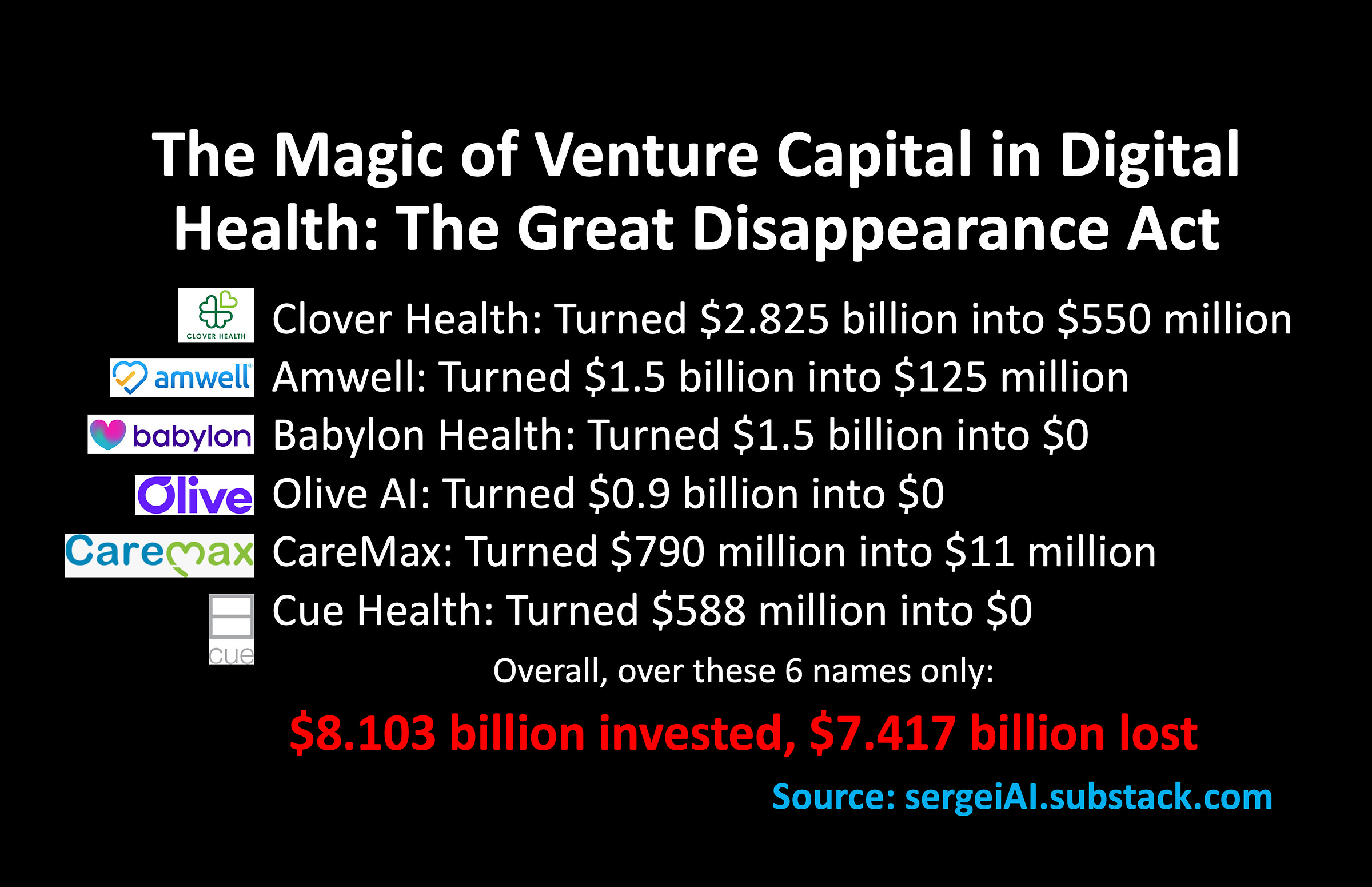Cue Health Plays Its Final Note: Another Victim of VC's 'Pump & Dump' Scheme
Same ol' story. General Partners get super rich at the expense of the "mom-and-pop" investors who got super screwed.
Welcome to AI Health Uncut, a brutally honest newsletter on AI, innovation, and the state of the healthcare market. If you’d like to sign up to receive issues over email, you can do so here.
Another day, another victim of venture capital and the ‘fake it ’til you make it’ mentality.
On Tuesday, May 28, 2024, another digital health “unicorn” bit the dust. Cue Health, a “one-trick COVID pony”, announced a Chapter 7 bankruptcy. (Source: Yahoo Finance.)
In itself, this is a non-event. The chance of a startup becoming a unicorn is only 0.00006%! 9 out of 10 startups fail, but, shockingly, 999 out of 1000 unicorns fail in terms of losing their value. Yet, we talk about unicorns all the time, with not enough focus on the invaluable lessons from their failures. I tried to do my part with the “10 Lessons from 30 Recent Digital Health Failures”, but it’s not nearly enough.
I want to meet a startup founder who has the wisdom and the courage to shut the business down and cut losses before absolutely everything is lost, as in Cue Health’s case.
Have you ever met a startup founder courageous and ethical enough to shutter her venture rather than rationalize excuses for another “pivot”, begging for more funding?
I’ve only met one such founder: Tracy Warren, co-founder & CEO of Astarte Medical, who was honest with herself. She saw the money-losing trend for her company, evaluated the situation, and instead of milking investors for more money and prolonging the inevitable, decided to save investor money by cutting losses early. Specifically, in the summer of 2023, the company secured a convertible note, setting performance benchmarks for the end of the year. These benchmarks were not met, and Tracy decided to dissolve the company to minimize investors’ losses. (Source: WTF Health on YouTube.)
That’s what ethical people do, no matter what business and what life situation you’re in. Brava! 👏
What do you think Olive AI and Babylon Health would have done in this situation? We know the answer. They would’ve blamed others for their failures and found reasons for a “pivot” – a term often used to justify draining investors’ funds. Olive AI, for instance, “pivoted” 27(!) times, each time finding a convincing explanation for burning more cash. As an investor, wouldn’t you become suspicious after the 5th, 10th, or even the 26th pivot?
By the way, why do more unicorns fail than regular startups? The answer may be found in the early 1600s Netherlands in the infamous “Tulip Mania”.
In his new book, “Unicorns, Hype, and Bubbles: A Guide to Spotting, Avoiding, and Exploiting Investment Bubbles in Tech”, Dr. Jeffrey Funk argues that the story of unicorns is one of hype and bubbles, and of startups with big goals but no way to reach them. Many of these startups did not use new technologies and were thus destined to fail. Others used new technology but assumed the technologies would diffuse so fast that they didn’t need to think about the first users and applications.
I believe that VCs (and, to some extent, founders) play a big part in the story of unicorn bubbles in tech. VCs create bubbles to enrich themselves at the expense of retail investors. Plain and simple.
In the old days, the 1980s and 1990s, no respected venture capitalist, and certainly no respected investment bank, would take a technology company public if the company was losing money. It was just unheard of. These days, especially in digital health, it’s hard to find a startup going IPO that is actually turning a profit.
I’m not going to dwell too much on this, as I’m preparing a special research article on the role of venture capital in technology and healthcare.
In this piece, I want to investigate what happened with Cue Health and what lessons startup founders, venture capitalists, policymakers, regulators, economists, patients, doctors, and investors could learn from this fascinating story.
So let’s begin. Here is the outline:
1. Cue Health: How It All Started
2. Cue Health’s VC Bros
3. Cue Health’s Cheating Scandal and Bankruptcy
4. How VCs Screwed Cue Health’s Shareholders Through a ‘Pump & Dump’ Scheme - This Picture Is Worth a Thousand Words
5. IPO Underwriting Banks Knew They Were Selling a “Lemon”
6. Corrupt Wall Street Analysts
7. The Magic of Venture Capital in Digital Health: The Great Disappearance Act
8. My Take
Keep reading with a 7-day free trial
Subscribe to AI Health Uncut to keep reading this post and get 7 days of free access to the full post archives.





